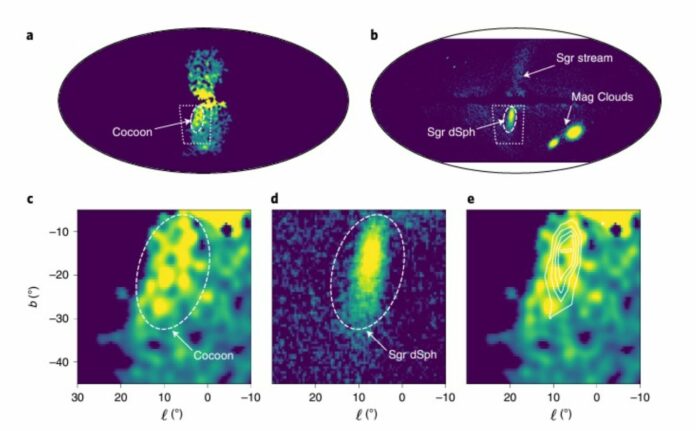An international team of scientists conducted a study that shed new insight on the origins of a bright region of gamma radiation at the center of our Milky Way galaxy.
The research focused on Fermi bubbles, which are two globe-shaped objects discovered by the Fermi Gamma-ray Space Telescope and span 50,000 light-years.
Previous research has found a substructure within the Fermi bubbles, which has been interpreted as a hallmark of collimated outflows from the Galaxy’s supermassive black hole.
In this new work, the team demonstrates through the use of a spatial template analysis that the Sagittarius dwarf spheroidal galaxy is most likely the source of the majority of the γ-ray emission associated with the brightest region of substructure, the so-called cocoon (dSph).
The Australian National University’s (ANU) Associate Professor Roland Crocker, a co-author of the paper, noted that some sections of these enigmatic Fermi bubbles are exceptionally bright.
“One of the brightest spots, the Fermi cocoon, is found in the southern bubble,” added Associate Professor Crocker.
The findings of their study show “it’s actually coming from the Sagittarius dwarf galaxy”.
The Solar System is positioned to observe this enormous Milky Way satellite through the Fermi bubbles.
The Sagittarius dSph has no current star formation as it is a tidally and ram-pressure stripped remnant, but they nonetheless show that the dwarf’s millisecond pulsar population can legitimately give the γ-ray signal that their research connects with its stellar template.
The measured spectrum is naturally described by inverse Compton scattering of cosmic microwave background photons by high-energy electron-positron pairs injected by Sagittarius dSph millisecond pulsars, along with magnetospheric emission from these objects.
This study shows that millisecond pulsars emit large γ-ray emission among elderly star populations, potentially complicating indirect dark-matter searches in areas like the Galactic Center, the Andromeda galaxy, and other big Milky Way dSphs.
Source: 10.1038/s41550-022-01777-x
Image Credit: Getty
You were reading: Australian Researchers Reveal The Secrets Of Mysterious Fermi Bubbles
